| INTERVIEW WITH DAN SPIEGLE By Dan Gheno . . PART TWO |
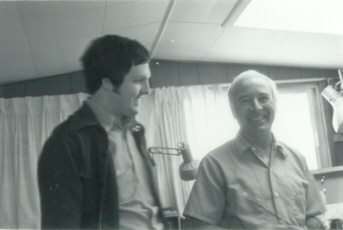 |
| ____________________________ |
Dan Spiegle (R) in his studio,
with a frequent collaborator |
| INTERVIEW WITH DAN SPIEGLE By Dan Gheno . . PART TWO |
 |
| ____________________________ |
Dan Spiegle (R) in his studio,
with a frequent collaborator |
Q: You did a comic strip after "Hoppy" was cancelled, didn't you?
Dan Spiegle: Yes, "Penn & Chris"--- and
while I
thought I had it sold a couple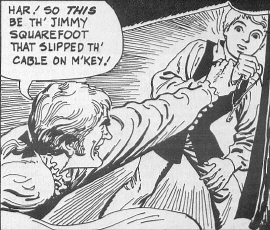 of times, it was never picked up by a syndicate.
They were having trouble with sailing strips, at this time, and since mine was
based on pirates, that let me out.
of times, it was never picked up by a syndicate.
They were having trouble with sailing strips, at this time, and since mine was
based on pirates, that let me out.
Q: And you moved to Western publishing Company...
Dan Spiegle: Western was lassoing any artist into their corral who had prior experience, so they happily set me to work doing -----westerns. This was about the time of the great cowboy mania saturation peak in comic books, around `55 or
`56.Q: What was your favorite comic book of that time?
Dan Spiegle: Well, I rarely look back into my past. The story I'm drawing at the time is my main concern. Nonetheless, I would say my favorite was Maverick, which ran about three years----fairly successful, considering the run of other western strips published then.
I was assigned this strip even before they had stills available for the show, so I was sent down to Warner Bros. to see it in production----where I met James Garner, which is perhaps the reason I enjoyed it so much. Having met the star, I was extra careful to make the drawings I did look as parallel to the real person as possible. I put my all into that strip, having fun all the way.
Q: How did you come to draw "Space Family Robinson"?
Dan Spiegle: At that time, Del Connell, a Western editor,
was writing the origin issue for the new magazine, and they asked me to draw up
a cast of characters.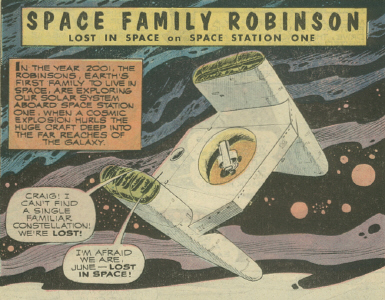 Western liked them so much that they assigned me the
strip. It was a success right
Western liked them so much that they assigned me the
strip. It was a success right
In fact, it was so popular that CBS stole our idea and refused to pay us any royalties! We were going to sue, but our lawyers cautioned against it, since we were doing so many comic books on their characters, and in the long run we would lose from the loss of business from them. So we adopted their title and added it to ours in hope of deriving some publicity off the tv show.
Q: Did you have any set plans drawn for the space station?
Dan Spiegle: No. Space Station #1 just progressively evolved out of my imagination. One thing led to another, and I had a fully equipped space ship with solar gardens, space pods, and the whole works. I fashioned the space pods, by the way, out of my electric razor. The only law that was set out before me concerning the design was that I was not to make the space station look like one of those round uninteresting satellites, the type that satellites are "supposed" to look like.
Q: You took over Korak when Russ Manning left Western to
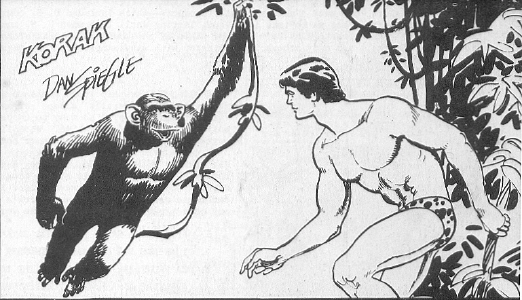 do
the "Tarzan" newspaper strip---did you have much trouble adapting to his
version?
do
the "Tarzan" newspaper strip---did you have much trouble adapting to his
version?
Dan Spiegle: No one likes to copy someone else's style, and it was particularly difficult since Russ and I were using entirely different pens for the inking. It wasn't too hard, though, for me to adjust to the Korak characterization, since Russ had done only about ten issues of the magazine. All that was necessary to foster the continuity was to keep his hairdo and youngish appearance intact.
Magnus, Robot Fighter [another Manning-drawn comic book] was another thing altogether, since I was asked to do only an interim issue before another artist took over. The New York office [Western has two editorial offices, one in Hollywood for the West Coast, and a main office in New York] asked me to draw exactly the same as Manning. Quite impossible!
Q: Did you enjoy working with editor Joe Kubert on his "Unknown Soldier" creation?
Dan Spiegle: Yes, very much. I learned a great many new
ways of going about telling a story from him. Unfortunately, the fact that I
lived so far from New York [in Southern California] made working conditions
almost impossible. Obviously, since Kubert has all his heart into the character,
he wanted things done exactly the way he used to do it. Naturally, since I have
my own style, we sometimes conflicted on certain ways to tell the story. If I
lived closer to him, we would've been able to go over each and every panel to
our satisfaction. Alas, the phone rates between New York and California are such
that that couldn't be done, and I left the strip after two issues. It was 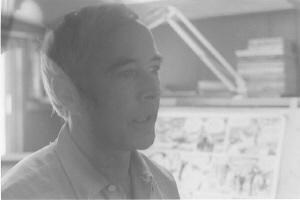 best
that he replace me with someone who could better understand what he wants out of
his character.
best
that he replace me with someone who could better understand what he wants out of
his character.
I did have an awful lot of fun, however ---- doing that war book gave me a chance to experiment on new storytelling ideas and concepts I normally wouldn't be allowed to do.
Q: Have you ever been censored?
Dan Spiegle: Western has its own code, not too strict or lenient. They usually leave it up to one's good taste. Here's where good composition can be utilized. For instance, you could position a gunman and his pistol in a close-up, firing, and then show the other cowboy dead in the next panel-obscured by a shadow of some sort. There's always a way to imply something like a dead body without having to show it outright.
The reason western didn't join the Comics Code association was that we were already abiding by our own code----and had for a long time---- and we didn't need another one to go by. We felt, however, that if the Comics Code could induce other companies to exercise good judgement once in a while regarding content, then more power to it. But we
didn't feel we needed someone else to tell us whether our work was in good taste.I've never been censored by Western myself----except once when I put too low a cut on the leading lady's blouse. However, many times I've been asked to change a panel or two when I send in my rough layouts for lettering. [Staff letterers do most of the lettering for the Western comics, following a standard practice in the industry.] They write around the borders of the paper, asking me to change a panel when it's needed to make the story more readable and to flow better. Often I find myself disagreeing with them, as many artists do I'm sure. But in the long run, the editor is usually right, since it's his job, and I'm sure he knows best how the reader will react to a certain panel----different from my viewpoint. But this happens only once in a while, asking me to change a panel or two.
Q: What's your main concern in drawing a story?
Dan Spiegle: I aim at creating as much depth in a crowd scene or a group of buildings as possible. The most important thing I attempt is to keep a continuity going in the strips, with the flow of the
characters going from right to left. It always hurts a story when you have someone running left to right, since it breaks up the reader's eye movement and he has to refocus.|
|
|
A" Penn and Chris" daily, demonstrating Spiegle's use of imagery to direct the viewer's eye rightward. |
Q: What's your working speed?
Dan Spiegle: I pencil about ten pages a day on the average. When I ink them it drops to three pages a day.
Q: Do you work at home?
Dan Spiegle: Yes. And working at home I find I can get off my easel for a few moments to an hour, to pull weeds or whatever, if I begin to get tired-----until my inspiration returns. Often, when I'm really
rolling, I work non-stop late into the night, from the early morning hours. Usually I find the first day on a story goes slow, but after two days I'm more involved with it, and I find myself working at a faster pace.Q: The reactions of people when they learn you're a comic book artist----are they ever critical?
Dan Spiegle: Certainly many people have sneered about the fact I'm a comic book artist. But no one as yet has tried to give me a lecture on the "evils" of comic books. Most people are basically polite, and won't tell you what they think of you to your face-----but I can see through to what they think. They envision comic books as the lowest form of literature. But I believe comic books have their own place.
I know for a fact that my children learned how to read better through comics, while also increasing their vocabulary with picture-word association.
Q: What changes would you make in comic books, if you could?
Dan Spiegle: I'd like to have comic books a little larger in size, on a better stock of paper that would reproduce better----so that the art we spend hours on could be better appreciated and the color would be
brighter. The coloring, too. At Western the artist has no choice as to how his art will be colored. That'd be my main concern. The colorer just slaps on any old gaudy color that's catchy----without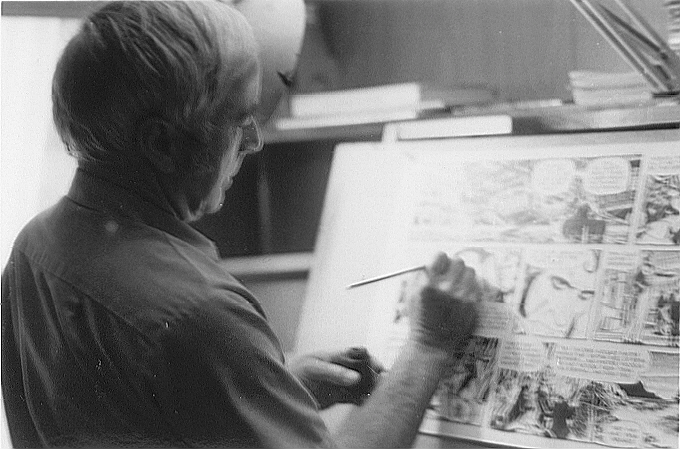 any regard to whether
it's night or day, the mood, or whatever. That's why I try to put so much black
in my art, so that the fella who happens to color it has less to mess up on. I
used to indicate what color I wanted, but they made me discontinue that practice
for they felt it was too much trouble for the colorer to follow my directions.
The only time I was allowed to color an entire issue, page for
page, was a Sea Hunt book I did. Doing the coloring myself,
I think I added more depth to the art.
any regard to whether
it's night or day, the mood, or whatever. That's why I try to put so much black
in my art, so that the fella who happens to color it has less to mess up on. I
used to indicate what color I wanted, but they made me discontinue that practice
for they felt it was too much trouble for the colorer to follow my directions.
The only time I was allowed to color an entire issue, page for
page, was a Sea Hunt book I did. Doing the coloring myself,
I think I added more depth to the art.
Western's digest-size comic books are an innovation whose future looks very bright. The only drawback with this type of book is that it makes all of the problems we have with the standard comic book more acute. Our art is even more cramped, and the coloring becomes that much worse on the miniature pages. Colors that were appealing in the original stories look horrid when reprinted at a reduced size. Better paper just might solve this.
Although the digest-sized books appear to be a success, they're only one answer. As a whole, the industry should be expanding in both size and page-count.
Q: What do we have to look forward to from you, now that you're no longer drawing a regular series?
Dan Spiegle: I'm getting very many scripts from the New York office for some of their mystery books, and I'll be doing quite a bit of art for Mystery Comics Digest. I'll also continue drawing the comic book versions of Walt Disney movies. The latest one I'm working on is "Napoleon and Samantha."
_________________________________
All photos ©2000 by Dan Gheno
_________________________________
Click Here to Return to: